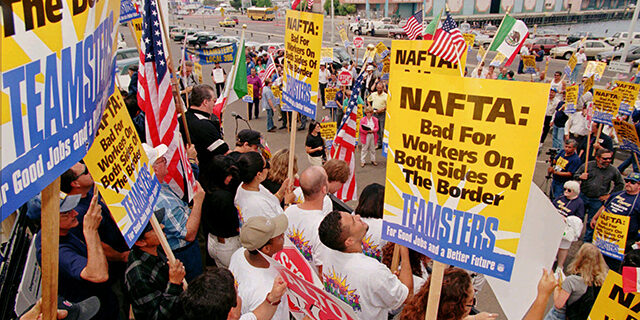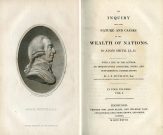Nature and imagination are twins, argued the great thinkers of classical liberalism.
Protectionism’s Endless Confusions
Whether it is stakeholder capitalism on the left or the turn to economic nationalism by some on the right, America and many other nations are experiencing a swing back towards interventionist policies. Free traders in particular find themselves on defense. The charges against them range from selling out American blue-collar workers in return for cheap shirts and inexpensive video games to being sycophants of Communist China.
The shallowness of these polemics is not difficult to demonstrate. What is often absent from these discussions is appreciation of the history of that mixture of ideas otherwise known as mercantilism—or, more precisely, neomercantilism—that gave shape and form to modern-day protectionism.
Historical inquiry into neomercantilism illustrates that it is a mistake to view arguments about modern international political economy as a contest primarily between economic liberalism and Marxism. Neomercantilist ideas have long been an equal player in that competition, perhaps even a dominant one at times. But the more you learn about neomercantilism’s history, the more apparent become the contradictions of the neomercantilist outlook driving many policies being advocated across the political spectrum today.
These are just some reasons why The Neomercantilists: A Global Intellectual History, authored by the political scientist Eric Helleiner, is an especially timely work. For Helleiner, neomercantilism describes that set of ideas that emerged in response to Adam Smith’s demolition of the assumptions and policy preferences underpinning what Smith famously called the “mercantile system” that dominated the European economic world from the mid-1500s until the late eighteenth century.
Understanding many economic policymakers’ choices in the nineteenth and twentieth centuries across the globe is difficult if neomercantilism’s influence is insufficiently appreciated. Grasping the scale and nature of that influence was what drew Helleiner to study neomercantilism’s place in debates about international political economy in the first place. As he researched the topic, however, Helleiner was particularly “struck by the absence of a comprehensive analysis of [neomercantilism’s] intellectual origins.”
The Neomercantilists represents Helleiner’s effort to correct that deficiency. His research more than fills the gap. It is both comprehensive and readable. At the same time, Helleiner’s analysis demonstrates 1) why neomercantilist thought has failed to overcome long-standing critiques of protectionist and state-led development programs and 2) why neomercantilist policies are nevertheless politically attractive.
Smith Sets the Standard
Helleiner does not set out to discredit neomercantilist thought. His goal is to identify and understand the core concepts driving this mode of thought, and the reasons why many intellectuals, economists, and policymakers embrace it. The result is a detailed study of the writings of neomercantilist thinkers. These include well-known figures such as the German-American economist Friedrich List (1789–1846), but also more obscure contributors like the Chinese politician Liang Qichao (1873–1929) and the Russian naval officer and prominent public official Nikolai Semenovich Mordvinov (1754–1845).
Helleiner’s analysis of the ideas articulated by these and many other neomercantilists establishes clearly how and why they arrived at their positive views of tariffs, subsidies, and industrial policy. He also carefully explains the ways in which their ideas did—or, just as likely, did not—align with each other. Two key insights emerge from this.
The first is that most neomercantilists readily conceded the truth of many of Adam Smith’s views on trade. That testifies to the power of Smith’s intellectual achievement. But it also underscores the neomercantilists’ recognition that, after The Wealth of Nations, there was no going back to either pre-Smithian economic theory or a pre-Smithian economic world. This is what makes them neomercantilists rather than simply recyclers of the arguments of pre-Smithian mercantilists like Smith’s fellow Scot, Sir James Steuart (1712–80).
The second of Helleiner’s insights concerns the sheer variety of neomercantilist thought. In many cases, this is derived from lasting and deep disagreements among neomercantilist thinkers themselves.
Many neomercantilists, for example, saw their ideas as part and parcel of a case for colonial expansion. By contrast, others regarded their economic prescriptions as contributing to the growth of peace among free nations in a world free from imperialism. Neomercantilists also disagreed about the economic objectives of their policies. Was it to get countries to the point whereby their industries could compete internationally without assistance from government? Or was protectionism to be a permanent state of affairs?
Who’s a Realist?
Initially one might conclude that these differences reflected a willingness on the part of neomercantilists to think creatively about the most optimal set of modern domestic and international economic arrangements. On closer examination, however, the often-stark dissimilarities owe much to the neomercantilists’ perpetual struggle to develop a coherent economic theory that transcended the particularities of the immediate contexts upon which neomercantilists invariably focused.
Another way of understanding this is that neomercantilists (much like their present-day successors) claimed to be realists. This is what made many neomercantilists hostile to the detailed theoretical structure of what many of them derided (again, like their intellectual descendants) as the “free trade religion” or “free trade theology.”
Helleiner points out, however, that free trade thinkers have just as much claim to being realists. Since Smith’s time, free traders have been concerned with knowing certain truths about human nature and their significance for economic life. That is realism in the deepest sense of the word. It is also the point of developing theories that reflects basic principles of reasoning associated with what Scottish Enlightenment thinkers called “the science of man.” The purpose of such theories was not abstraction for the sake of abstraction. It was to sift out the truth from the dross of error. What could be more realistic than that?
By contrast, the neomercantilists’ focus on the specifics of given situations made it difficult for them to develop an intellectually coherent position. They could not, for instance, provide principled reasons why one economic sector should receive favorable treatment from the government rather than another. The Romanian politician, fascist intellectual, and follower of List, Mihial Manoilescu (1891–1950), even conceded that protectionism was “bereft of any theoretical basis.” That shows up in the haphazardness characterizing the protectionist policies advocated by the neomercantilists covered in Helleiner’s book.
Opportunities can emerge for market-liberal ideas to shift policy settings in the direction of a freer economic world. But free traders should have no illusions: the sway of neomercantilist ideas on policymakers and citizens alike is powerful and persistent.
That inability to establish rational theoretical foundations explains the regular appeals to expediency by neomercantilists to justify their preferred policies. Over time, this led to serious inconsistencies in government economic interventions. Reliance on expediency to justify neomercantilist positions also created opportunities for what, in most cases, really underlies a tariff or industrial policy: the workings of special interests. The line between expediency and outright cronyism is a very fine one.
Exalting the State
Some neomercantilists were intellectually honest enough to recognize their theoretical weaknesses. To compensate for this, they sought legitimacy for their economic ideas by attaching them to political positions that acquired intellectual and political ascendency at particular historical periods. Among others, these included nineteenth-century imperialism, social Darwinism, and, from the mid-nineteenth century onwards, ideologies like corporatism, Latin American populisms of left and right, and aggressive forms of ethno-nationalism.
It isn’t a coincidence that advocates of neomercantilist policies tend to gravitate towards political positions that seek to bolster state power. This, it turns out, is not a bug in neomercantilism’s software. It is a central feature of the neomercantilist operating system. This constitutes a significant continuity between mercantilist and neomercantilist thought. To varying degrees, most of the neomercantilists highlighted by Helleiner shared the pre-Smithian conviction of figures like Louis XIV’s chief minister Jean-Baptiste Colbert (1619–83) that their version of political economy would build up the wealth and power of a state in often very unstable international political environments.
Figures like Colbert held that a strong and powerful state was necessary to produce great wealth and that great wealth facilitated a strong and powerful state. This mutually reinforcing axiom was attractive to proponents of national developmentalism in developing countries like Argentina in the 1940s as well as political leaders anxious to solidify particular political arrangements like Imperial Germany’s first Chancellor, Otto von Bismarck, in the late-nineteenth century. They came to regard neomercantilist policies as a way to make government the central player in economic life without utterly destroying market institutions.
Ironically, building up government power was not the primary goal of leading neomercantilists such as List. While List had difficulty delineating a principled framework for explaining why and how to apply tariffs, Helleiner shows that List was not concerned with enhancing the strength of centralized government for its own sake.
Here, however, some of the problems that bedevil neomercantilist policies become readily apparent. Perhaps the most prominent is that there is nothing in neomercantilism’s internal logic to place any decisive limitation on the endless expansion of state power. Neomercantilist policies thus tend to marginalize economic freedom over time and gradually turn ostensibly-free economic actors into mildly indentured servants of the state. The well-known consequences for political freedom are dire.
Can Free Trade Ever Win?
Is any of Helleiner’s research likely to change the views of contemporary exponents of neomercantilist policies? The odds are small. The prospect of acquiring power by implementing such policies is always a potent aphrodisiac for political leaders and technocrats unconcerned about neomercantilism’s long-term economic effects. Equally seductive is the idea that, if only the right people are in charge and given the appropriate tools, economies can be managed in ways that avoid the business cycle’s ups and downs on a domestic and international level. For those on the lower end of the economic spectrum, tariffs and industrial policy hold out the illusory prospect of endless economic security.
Nor can we discount just how many special interests rely on neomercantilist policies for their livelihood. The most obvious are politically connected businesses that resent competition. Another set of enablers are those legislators anxious to doll out favors in return for political support. Then there are the armies of trade lawyers whose wealth is derived from the fact that the sheer complexity of ever-changing rules and regulations associated with neomercantilist policies necessitates a class of people skilled at navigating the regulatory sludge. Take away the complexity via trade liberalization, demand for their services declines dramatically.
That said, Helleiner well and truly exposes, without any apparent intentionality on his part, the sheer instability inherent to neomercantilist policies and their intellectually fragile theoretical grounding. At different points in history, these weaknesses have become more obvious, as do the privileges that such policies bestow on special interests and their supporting cast of political and legal actors.
In such conditions, opportunities can emerge for market-liberal ideas to shift policy settings in the direction of a freer economic world. But free traders should have no illusions: the sway of neomercantilist ideas on policymakers and citizens alike is powerful and persistent. There is no guarantee that good ideas will overcome bad ideas. But if Helleiner’s book demonstrates anything, it is that free traders have intellectual clarity and rigor on their side. It is much more difficult to say the same about protectionists.



